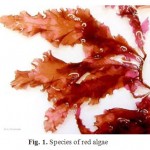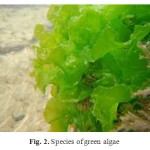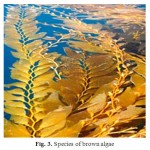How to Cite | Publication History | PlumX Article Matrix
Macro Algae Species and Their Potential Application as Raw Material for Biotech Products
Oladokun Sulaiman Olanrewaju1, Kong Fah Tee2 and Ab Saman Abd Kader3
1School of Ocean Engineering, University Malaysia Terengganu, 21030, Kuala Terengganu, Terengganu, Malaysia.
2School of Engineering Science, University of Greeenish, United Kindom.
3Marine Technology Center, University Technology Malaysia, 21030 UTM, Skudai, Johor, Malaysia.
DOI : http://dx.doi.org/10.13005/bbra/2166
ABSTRACT: Environmental considerations will increasingly determine use of macro algae product and improve process acceptability that drive the next generation of economic opportunity. Some countries including Japan are actively promoting a macro algae ‘green’ technology that is many growing demand worldwide in the coming decades.In this context, biomass refer to any source of heat energy that is produced from non-fossils biological materials. Unlike fossil fuels, biomass is a renewable energy resource that is available where the climatic conditions are favorable for plant growth and production. Different macro algae survive in different habitat. This paper describes review of microalgae species as well as qualitative and quantitative experimental analysis of the types of macro algae which are suitable cultivation.
KEYWORDS: Environmental; raw materia; Biotech products
Download this article as:| Copy the following to cite this article: Olanrewaju O. S, Tee K. F, Kader A. S. A. Macro Algae Species and Their Potential Application as Raw Material for Biotech Products. Biosci Biotech Res Asia 2015;12(spl.edn.2) |
| Copy the following to cite this URL: Olanrewaju O. S, Tee K. F, Kader A. S. A. Macro Algae Species and Their Potential Application as Raw Material for Biotech Products. Biosci Biotech Res Asia 2015;12(spl.edn.2). Available from:https://www.biotech-asia.org/?p=12754 |
Introduction
Background and Issues with Biofuel Energy Source
Marine macro algae are receiving increasing attention as an attractive renewable source for producing fuels and chemicals. Marine biomass energy sources although heavily subsidy as renewable energy sources. Macro algae species are very abundant in earth and they have high caloric energy value compare to other biomass sources. In addition to this, the biomass can also be use for carbon capture. The carbon capture is an approach to mitigate the global warming by capturing the carbon dioxide from the large point sources such as fossil fuel power plants and storing it instead of releasing it into atmosphere like technology for large scale capture of CO2 is already commercially available and fairly well developed (Asifa and Muneer, 2007). Besides, there is need to reduce the impact of global warming and climate change. Based on estimation in 2000, more than 20 metric tonne of carbon dioxide was release to the atmosphere every year (Saxenaet al, 2001). The macro algae cultivation can be reduces the released of greenhouse gas from the energy. Application of macro algae as the marine biomass energy sources, the net emission of carbon into atmosphere through carbon capture may reduce.The economy of all of the countries depends on the guaranty of energy sources.
Types Of Algae
Macro algae have four different types, which is Rhodophyta, Chlorophyta, Phaeophyta and CarpoCirus. Rhodophyta is the red algae that include various forms of crustose calcareous algae CCA which are abundant on offshore reefs of the Great Barrier Reef. The red algae or Rhodophytashown in Figure 2, are one of the oldest groups of eukaryotic algae and also one of the largest with about 5000-6000 specie of mostly multicellular marine algae. The red algae form a distinct group characterized by these attributes which is eukaryotic without flagella and centriols, using florideanpolysaccharide as food reserves with phycobiliprotein as accessory pigments and chloroplasts lacking external endosplasmic reticulum and containing unstacked thylakoids. Most of red algae are also multicellular, macroscopic, marine and have sexual reproduction. They often have alternation of generations and may have three generation rather than two. Many of the corraline algae, which secrete calcium carbonate and play a major role in buiding coral reefs belng here. Red algae such as Palmanari palmate and nori are a traditional part of European and Asian cuisines and are used to make other products such as agar, caarageans and other food additives. Most of the Rhodopytes are found in freshwater that generally prefer clean and in running water.
 |
Figure 1: Species of red algae
|
Chlorophyta species is a division of green algae, informally called chloropytes. In order to classification systems, it refers to a highly paraphytetic group of all the green within the green plants and thus includes about 7000 species of mostly aquatic photosynthetic eukaryotic organisms. Like the land plants, green algae contain cholorophyllsa and b and store food as starch in their plastids. Species of Clorophyta are common inhabitants of marine, freshwater and terrestrial environment. Several species have adapted to specialized and extreme environments such as deserts, arctic environments, hypersaline habitats, marine deep waters and deep sea hydrothermal vents. Some groups such as the Trentepohiliales are exclusively found on land. Several species of Chlorophyta live in symbiosis with a diverse range eukaryote, including fungi to form lichens, ciliates, Foraminifera, Cnidaria and mollucs. Some species of chlorophyta(Figure 3)are heterotrophic, either free-living or parasitic. The heterotrophic green alga Prototheca can cause infections in humans and animals known as protothecosis.
 |
Figure 2: Species of green algae
|
The Phaeophyta or brown algae is a large group of mostly marine multicellular algae, including many seaweeds of colder Northern Hemisphere waters. They play an important role in marine environments, both as food and for the habitats they form. For instance Macrocystis, a kelp of the order Laminaries, may reach 60m in length, and forms prominent underwater forest. Another example is sargassum, which creates unique habitats in the tropical waters of the Sargasso Sea. Many brown algae shown in Figure 4 , such as kelp are used as food for humans. Brown algae exist in a wide range of sizes and forms. The smallest members of the group grow as tiny, feathery tufts of threadlike cells no more than a few cm long. Some species even have a stage in their life cycle that consists of only a few cells, making the entire alga microscopic. Other groups of brown algae grow too much larger sizes. Kelps can range in size from two-foot-tall sea palm Postelsia to the giant kelp Macrocystispyrifera which grows to over 45m long and is the largest of all the algae Brown algae have adapted to a wide variety of marine ecological niches including the tidal splash zone, rock pools, the whole intertidal zone and relatively deep near shore waters. They are important constituent of some brackish water ecosystem and four species are restricted to life in fresh water. A large number of predominantly cool and cold water organisms that benefit from nutrients in up welling cold water currents and inflows from land, Sargasum being a prominent exception to this generalization.
 |
Figure 3: Species of brown algae
|
Producing Marine Macro Algae
As world energy demand continues to rise and fossil fuel resources are depleting, marine macroalgae (i.e., seaweed) is receiving increasing attention as an attractive renewable source for producing fuels and biochemical. Product marine plant biomass has many advantages over terrestrial plant biomass for example they are use as a feedstock. Recent breakthroughs in converting diverse carbohydrates from seaweed biomass into liquid biofuels for example bioethanol through metabolic engineering have demonstrated potential for seaweed biomass as a promising, although relatively unexplored according to biofuels (Na Wei, 2013).Marine biomass energy system in Japan was proposed consisting of seaweed cultivation (Laminariajaponica) at offshore marine farms, biogas production via methane fermentation of the seaweeds, and fuel cell power generation driven by the generated biogas. The estimated CO2 mitigation is equivalent to about 0.9% of the required CO2 mitigation for Japan per annum under the Kyoto Protocol framework (Shinya Yokohama, 2008).
Brown macro-algae that commonly found around the British coasts are mainly used as a source of many useful industrial chemicals such as phycocolloids (e.g. alginates). Conversion of macro-algae into biofuel has largely focused on the production of biogas by anaerobic digestion (Hanssen et al., 1987; Hansson, 1983; Matsui and Koike, 2010).Some recent studies have focused on the utilization of the sugars present in seaweed (mannitol and laminarin for brown algae) in order to produce bio-ethanol by fermentation (Adams et al., 2009; Choi et al., 2009; Horn et al., 2000).Marine macro algae are one such source of aquatic biomass and potentially represent a significant source of renewable energy. The average photosynthetic efficiency of aquatic biomass is 6–8% (Renewable biological systems for alternative sustainable energy production, 1997) which is much higher than that of terrestrial biomass (1.8–2.2%). Either microalgae or marine macro algae (kelp or seaweed) could be used for solar energy conversion and biofuel production. (A.B. Ross, 2007).
Brown macro algae that commonly found around the British coasts are mainly used as a surce of many useful industrial chemicals such as phycocolloids (eg alginates). Conversion of macro algae into biofuel has largely focused on the production of biogas by anaerobic digestion (Hanssen et el, 1987 ; Hansson, 1983 ; Matsui and Koike, 2010).Some recent studies have focused on the utilization of the sugars present in seaweed (mannitol and laminarin for brown algae) in order to produce bioethanol by fermentation ( Adams et al, 2009; Choi et al ; Horn et al, 2000).
Marine macro algae are one such source of aquatic biomass that potentially represent a significant source renewable energy. The average photosynthetic efficiency of aquatic biomass is 6- 8% (Renewable biological systems for alternative sustainable energy production, 1997) which is much higher than that of terrestrial biomass is 1.8- 2.2%. either microalgae or marine macro algae (kelp or seaweed) could be used for solar energy conversion and biofuel production (A.B.Ross, 2007) Biomass, either terrestrial or aquatic, is considered a renewable energy source with quasi zero-emission. Among alternative energy sources, biomass represents the most ready to be implemented on a large scale without many environmental or economic penalty. The photosynthetic efficiency of aquatic biomass results to be much higher than 6– 8%, average compare to that of terrestrial (1.8–2.2%, average). This makes the former more adapt for an enhanced CO2 fixation to afford a high biomass production. Also, aquatic biomass presents an easy adaptability to grow in different conditions, either in fresh or marine waters, and in a wide enough range of pH. The pond culture of algae presents the advantage of usage of carbon dioxide emitted by electric power plants, using of wastewater that may supply the amount of required nutrients. Micro-algae have received so far more attention with respect to macro algae as agents for enhanced CO2 fixation due to their facile adaptability to grow in ponds or bioreactors and the extended knowledge on several strains used for fish feeding. Only recently they have been considered for energy production, and the potential of some Pacific Ocean strains has been preliminarily studied ( M. Aresta et al, 2005).
Application
While the general idea of using algae for energy production has been around for over 50 years, the concept of using lipids derived from algal cells to produce liquid fuels arose more recently. (Ayhan Demirbas,2010). According to the Michele Aresta, (2005) macro-algae are extensively grown and used as food in Asiatic Countries, or as source of chemicals. They are usually collected from natural water basins where they are seasonally available. Only recently they have been considered for energy production, and the potential of some Pacific Ocean strains has been preliminarily studied. The Life Cycle Assessment (LCA) methodology has been applied to evaluate the energy production from macro-algal biomass. We have developed specific software (COMPUBIO) which can be used for an energetic, environmental or economic evaluation.
Needless to say, the world population is increasing at an alarming rate and so is the liquid fuel demand in the transport sector. Global warming, depletion of fossil fuels and increasing price of petroleum-based fuels are gaining great concern and the exigency of the situation has forced the search for alternative, sustainable, renewable, efficient and cost-effective energy sources with lesser green house gas emissions (Nigam and Singh, 2010). Biomass can serve as an excellent alternative source to meet the present and future fuel demands.The use of seaweeds for food and as medicines was recorded in China some thousands of years ago, and in parts of Asia seaweed products have for many years been widely used, if not staple, food items. In the western world seaweeds have traditionally been valued principally for their properties as animal feed and fertilizers and, during the eighteenth and nineteenth centuries, as a source of soda, iodine and other chemicals. (Darson,1966).
The underlying physiological of algae antioxidant compunds is reviewed in the context of seaweed biological utilization. The application of seaweed antioxidants in foods, food supplements, nutraceutical and medicine is considered form the perspective of benefits to human health. We advocate that direct consumption of seaweed products for their antioxidant composition alone provides a useful alternative to non-natural substances, while simultaneously providing worthwhile nutritional benefits. Economic utilization of seaweed for their antioxidant properties remains in its infancy. This review examples ranging from laboratory studies through to clinical trials where antioxidants derived from seaweeds may provide majr health benefits that warrant subsequent investigate studies and possible utilization (M. Lynn Cornish, 2010).
Environmental Impact Consideration
The influence of salinity and temperature in the areas of planned wind farms will not vary extensively and will be similar at all locations while remaining at all times in the tolerance to optimum range of the culture candidate species (AlmadeVillela et al. 1982, Widdows&Donkin 1992, BSH 2003). The concentrations of pollutants (e.g. heavy metals, pesticides and near-surface agents) can be considered unperilous.
Besides geological and topographical variations, water temperature and currents have also caused differences in macro algae composition between the northern and southern parts of the Pescadores and Taiwan. The two main currents affecting the coastal areas of Taiwan are the Kuroshio Current and the Mainland Coastal Current. The Kuroshio Current brings water of higher temperature and salinity up from the Philippines and the equatorial regions toward southern Taiwan where it branches into two. The stable, main branch with higher that 20oC water temperature runs past the east coast of Taiwan where some tropical species are found. A smaller branch, subjected to seasonal variability, veers northwestward through the Taiwan Strait to the southern parts of the Pescadores. Flowing south along the Chinese mainland coastal region, the Mainland Coastal Current carries colder water from East China Sea to the northern parts of Taiwan Strait, and is particularly strong in summer and less so in winter. Typhoons also occur disturbing the coastal areas every year and have caused considerable damages to marine ecosystems (Jui- Sheng Chang and Chien-Chang Tseng, 2010).
Conclusion
The paper reviewed species of macro algae to bring light into its application as material for biotech products. The use of algae include food production of useful compounds for food supplement, as bio filters to remove nutrients and other pollutant from wastewaters, to record water quality, as indicators of environmental change, in space technology, and as laboratory research systems. Algae can also be use to make biodiesel and biobutanol can produces vastly superior amounts of vegetable oil, it is prefer to compared terrestrial crops grown for same purpose. It also can be used to produce hydrogen. The use of macro algae as the marine biomass energy sources has the potential to offset substantial use of fossil fuels.
References
- S. K. Singh ,Seema , A Textbook of Algae. Campus Books International. 2008; 313- 322.
- Demirbas A, Arin G., . Hydrogen from biomass via pyrolysis ; relationships between yield of hydrogen and temperature . Energy Sources, 2004; 26:1061-9.
- Nisizawa, ,Noda, H.,Kikuchi, R. & Watanabe, T., The main seaweed foods in Japan. Proc. Intl. Seaweed Symp. 1987; 12: 5-29.
- Chiang, Y .M and W. L. Wang, Distribution of seaweed of the Hengchun Peninsula, TK.
- H. Chang (ed), Marine science. National Science Council Symposium Series 1987; 10: 71-87.
- Indergaard, M. &Minsaas, , Animal and human nutrition. In Guiry, M. D. & Blunden, G. (Ed.) Seaweed Resources in Europe: Uses and Potential. John Wiley & Sons, Chichester, 1991; 21-64.
- Janet R. , Handbook of Physicological Methods. Press Syndicate of the University of Cambridge, 1973.
- Haug, A. & Jensen , , Seasonal Variations on the ChecmicalCopmosition of Alariaesculenta, Laminariasaccharina, Laminariahyperborea and Laminariadigitata from Northern Norway. Reports of the Norwegian Institute of Seaweed Research No. 4, 1954.
- Chang, J. , The Taxonomy, life cycle and seasonal growth of Vodium and its effect on coral communities in Nanwan Bay, southern Taiwan.Ph. D dissertation, the Institute of Oceanography, National Taiwan University, 2002; 144.
- Guillermo Diaz-Pulido and Laurence J. McCook Macroalgae (Seaweeds). Environmental Australian Government Great Barrier Reef Marine Part Authority, 2008.
- Jensen, A. Component sugars of some common brown algae. Rep. Norw. Inst. Seaweed 1956; 9.
- Jensen, A. Preliminary investigations of the carbohydrates of Laminariadigitata and Fucusserratus. Rep. Norw. Inst. Seaweed 1956; 10.
- Morgan, C.,Wright, J.L.C. & Simpson, F.J. Review of chemical constituents of the red alga Palmariapalmata (dulse). Econ. Bot. 1980; 34:27-50.
- Arasaki, S. &Arasaki, T. Vegetables from the Sea. Japan Publ. , Tokyo, 1983.
- Baardseth, , Synopsis of biological data on knobbed wrack Ascophyllumnodosum (Linnaeus) Le Jolis. FAO Fisheries Synopsis 1970; 38: 1-38.
- Dawson (1966). Fisheries and Aquaculture Department: Production, Trade and Utilization of Seaweeds and Seaweed Products. Retrieved from http://owl.english.purdue.edu/owl/ resource/560/10/

This work is licensed under a Creative Commons Attribution 4.0 International License.





